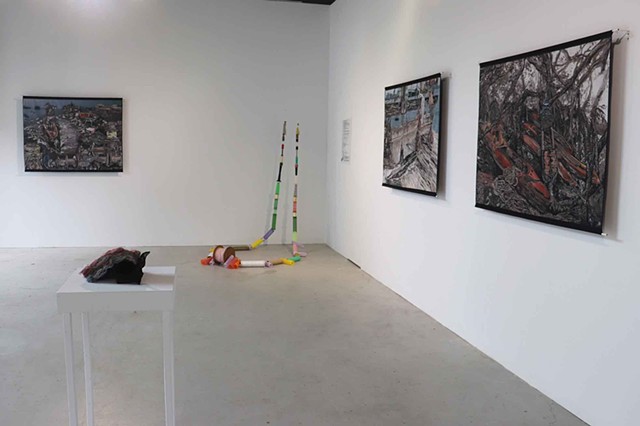COTTON Project
The artist creates the relationship with the bobbins and the shuttles that are used in the port and weaving industry. She connects steel, petrochemicals and military affairs through soft fabrics, and the works describes the multidimensional dimensions of industry, trade and environment.
The exhibition extends from the threads, bobbins and weaving shuttles that are used as tools in the textile industry. The bobbins are used as pillars, made by wood, paper and plastic for winding the yarn on. The shuttles are a tool made with different styles and function to protect the fine yarn from snagging and carry the weft as it passes over and under the warp across the loom. The progress of textiles not only depends on the invention of the tool technology, but also on the evolution of geography, climate and human development. The development of textiles is a tale of legend and adventure, industrial espionage and exchanges between region and culture. This project furthers the discussion of landscape and cultural colonization through the bobbins and shuttles. The work not only traces the history of industrial growth and trade, but also reflects on Taiwanese environmental changes and political climate within its developmental timeline. The art itself uses fiber as a medium to interpret the complexities of life, activities and global visions.
During her three-month stay in the Pier-2 Culture Residency in Kaohsiung, the artist conducted research through literature, field work and interviews to created this body of work. Kaohsiung is an industrial city in Taiwan. It went through the Japanese occupational period, infrastructural development from heavy industries such as steel, shipbreaking, shipbuilding and petrochemical industry after WW2 until now. The Yan-cheng district connects the international ports and commercial trade. The exhibition uses salt as a medium to wind (Note 1) the products, policies, ecology, etc and to become the yarn rolls. “Extending From The Bobbins And Shuttles” is the side chapter of her Cotton Research Project, which examines the notion of the endless ocean scape, the extension of cultural colonization, and the sustainability of ecological environment. Attempting to expand our way of thinking and interpreting the world, the artist integrates the materials from the petrochemical industry to future textiles, from artificial fibers to scoby (symbiotic culture of bacteria and yeast) leather, and creates multimedia installations through painting, videos, textiles and sculptures.
There are five chapters of the series of Cotton Research Project. All unfold the development of the global materials industry to connects the hidden links behind society and capitalism by using textiles which are regarded as a worldwide language. These links transcend time and space, and try to expand our imagination of history, present and future. In order to embody a fresh dialogue with the world around us.
Note 1: Winding refers to the technology of winding the yarns and threads on a tube, pole, cone or bobbin during the weaving process.
